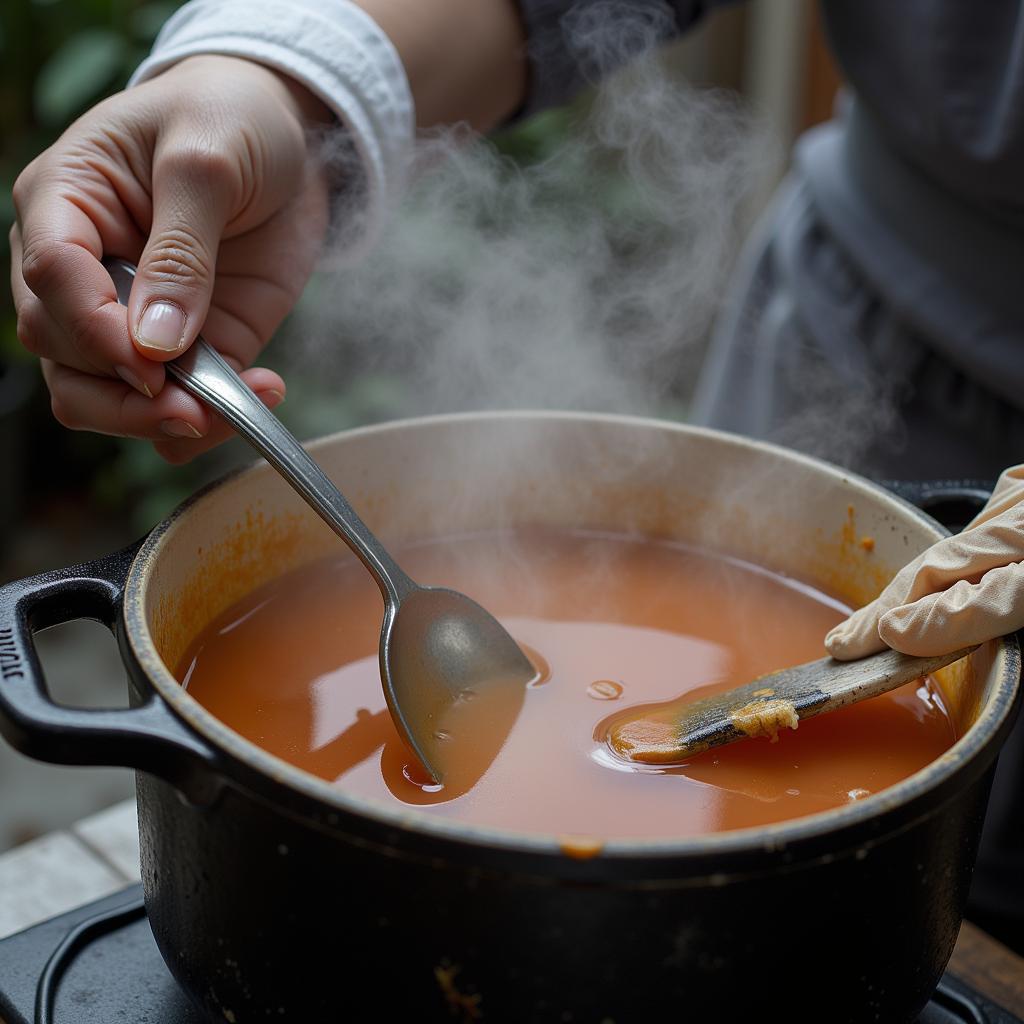Nylon fabric, known for its durability and versatility, can be a fantastic canvas for vibrant colors. Whether you’re reviving a faded garment or creating a unique piece, knowing how to color nylon fabric effectively is key. This guide provides comprehensive steps and tips to achieve professional-looking results.
Understanding Nylon and Dye Compatibility
Before diving into the dyeing process, understanding nylon’s properties is crucial. Nylon is a synthetic fabric, meaning traditional dyes for natural fibers won’t work effectively. Is it okay to mix white clothes with colored? While that might be a concern with regular laundry, dyeing nylon requires specific acid dyes that bond with the synthetic fibers. These dyes are available in powder or liquid form and offer a wide range of vibrant and long-lasting colors. Choosing the right dye ensures optimal color absorption and prevents fading.
Preparing Your Nylon Fabric for Dyeing
Pre-washing your nylon fabric is essential to remove any finishes or residues that might interfere with the dye’s penetration. Use a gentle detergent and warm water. Avoid fabric softeners, as they can create a barrier against the dye.
Dyeing Nylon Fabric: A Step-by-Step Guide
-
Gather Your Supplies: Besides acid dye and pre-washed nylon fabric, you’ll need a stainless steel pot (avoid aluminum), gloves, a respirator (for powder dyes), white vinegar, and a heat source.
-
Prepare the Dye Bath: Fill the pot with enough water to allow the fabric to move freely. Heat the water to a simmer, following the dye manufacturer’s instructions for the specific temperature.
-
Add the Dye: Dissolve the acid dye in a separate container with hot water and then add it to the dye bath. Stir well to ensure even distribution.
-
Add the Fabric: Slowly immerse the pre-washed nylon fabric into the dye bath, ensuring it’s fully submerged and can move freely.
-
Maintain the Temperature and Stir: Keep the dye bath at the recommended temperature and stir frequently to prevent uneven dyeing. The dyeing time varies depending on the dye and desired color intensity, typically between 30 minutes to an hour.
 Stirring Dye Bath with Nylon Fabric
Stirring Dye Bath with Nylon Fabric
- Rinse and Neutralize: After the dyeing time, remove the fabric from the dye bath and rinse thoroughly under cool running water until the water runs clear. Then, prepare a neutralizing bath with cool water and white vinegar (follow the dye manufacturer’s instructions for the vinegar ratio). Soak the dyed fabric in the neutralizing bath for about 15-20 minutes to set the color and remove excess dye.
Tips for Successful Nylon Dyeing
- Test the dye on a small, inconspicuous area of the fabric before dyeing the entire piece. This ensures the color is as desired and helps prevent unwanted surprises.
- Use accurate measurements for the dye and water to achieve consistent results.
- Avoid overcrowding the dye bath, as this can lead to uneven dyeing. How to dye socks with food coloring offers a different approach for smaller items, but for larger nylon pieces, acid dyes are the way to go.
- Wear gloves throughout the process to protect your skin from the dye.
- If working with powder dyes, wear a respirator to prevent inhalation of dye particles.
Troubleshooting Common Nylon Dyeing Issues
Uneven coloring can occur if the fabric isn’t stirred frequently or if the dye bath is overcrowded. Streaks can also be caused by insufficient pre-washing. If the color isn’t as intense as desired, you might need to increase the dye amount or dyeing time. Can you dry different colors together? While this is a separate laundry issue, proper rinsing after dyeing is crucial to prevent color bleeding onto other items later.
Expert Insights
Meet Amelia Dupont, a textile chemist with over 20 years of experience in dyeing and fabric finishing. Amelia emphasizes the importance of using high-quality acid dyes for nylon. “Investing in quality dyes ensures vibrant, long-lasting color and minimizes the risk of fading or color bleeding,” she advises.
Conclusion
Coloring nylon fabric can transform ordinary items into vibrant, personalized creations. By following these steps and tips, you can achieve professional-looking results and enjoy the satisfaction of creating unique, colorful pieces. Remember to always test the dye on a small area first and follow the manufacturer’s instructions for the specific dye you are using. How to color nylon fabric effectively lies in understanding the process and using the correct materials.
FAQ
-
What type of dye should I use for nylon? Acid dyes are specifically formulated for synthetic fibers like nylon.
-
Can I dye nylon with natural dyes? Natural dyes generally don’t bond well with synthetic fibers like nylon.
-
How do I prevent uneven dyeing? Stir the dye bath frequently and ensure the fabric can move freely.
-
What should I do if the color isn’t intense enough? Increase the dye amount or dyeing time.
-
How do I set the color after dyeing? Rinse the fabric thoroughly and then soak it in a neutralizing bath with white vinegar.
-
Can I dye nylon fabric in the washing machine? It’s recommended to dye nylon in a stainless steel pot on the stovetop for better control and even dyeing.
-
Where can I find acid dyes? Acid dyes are available online and at some craft and fabric stores.
More Questions?
Need assistance with your nylon dyeing project? Contact us at Phone: 0373298888, Email: [email protected], or visit our store at 86 Cau Giay, Hanoi. We have a 24/7 customer service team ready to help.

